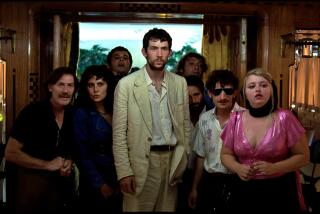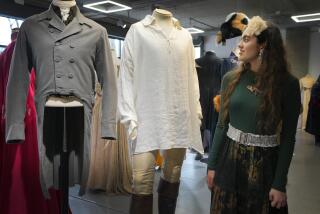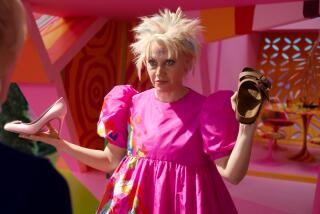‘Anna Karenina’s’ 1870s-1950s costume mash-up
The Leo Tolstoy classic “Anna Karenina” has seen its share of adaptations. In its latest turn, from director Joe Wright, the love story gets a bold, creative and visually beautiful reworking of the Russian tale with truly inventive costuming.
Starring Keira Knightley and Jude Law, Focus Features’ film is strikingly original in its setting — the drama is staged on a decaying theater set — which gave Wright’s longtime costume designer Jacqueline Durran, [who has been nominated for an Oscar for two previous projects with Wright, “Pride & Prejudice” and “Atonement”] the latitude to combine Old World antique opulence and contemporary glamour.
Joe Wright often comes to his films with specific visual ideas of how he wants his characters to look. Is this something that makes designing more or less complicated?
It depends on your temperament, really. It suits me. It’s not that his brief [initial pre-production discussion] covers all angles; it’s more about clear touchstones of what you’ve got to do, what you’re trying to achieve.... I then try and work out how to put that vision into the practical.
VIDEO: Keira Knightley, Joe Wright talk making of ‘Anna Karenina’
So, Joe said, “I want to concentrate on silhouette, on certain details, and the way into that idea is to look at ‘50s couture. Look at the kind of bold shapes and asymmetric styles, and then use that to bring Anna to life.”
Looking at some of French designers Balenciaga and Dior’s 1950s gowns today, they really could just have been plucked and put on Anna. Do you know how he came up with the idea of mixing 1950s couture with 1870s Russian dress?
No. [Laughs.] I don’t ask him. Because he has a great sense of the visual, and I think I have a slight unwillingness to have it all laid out. I quite like the idea of just doing it.... I really overlaid the ‘50s because I wanted it to be quite obvious that there was something going on here and that I wasn’t just doing costumes, that I was actually trying to do a style. So the ‘50s thing I maybe pushed it a bit harder.
This was especially so for Anna and [Princess] Betsy [Tverskoy, played by Ruth Wilson]. And Betsy was even more extreme as she had the influence of a Japanese geisha, which is why she has the interesting sculptural shapes to her clothes. That was her angle, and I don’t know why. [Laughs.] And then … Kitty’s thing is she’s childlike, and when you trim off all the Victorian details, you’re left with a silhouette that’s very easy to combine that generic Victorian, more crinoline shape with the 1950s.
I love the way all the various parts of Russian society were choreographed and layered by costume design.
One of the things I really liked and I don’t know if people will notice: During the ball, all the women wear the same dress. There are 25 female and 25 male dancers, and the men wear two different styles of costumes but the women wear the same dress in 25 different shades of sour pastels. That was our idea to show the decay of their society. And the female societal group was always together, so it gave you a contrast with Anna. Joe had the idea of making them like a chorus in a theater. And then the servants all had the generic Russian grays that blended in: They could not participate in society — it kind of stratified society like that.
REVIEW: ‘Anna Karenina’s’ artifice overshadows actors
Were the military uniforms, especially Vronsky’s, true to period and color?
I’d say they were an approximation of a correct uniform. We did not slavishly try to be correct in any way. We looked at pictures of Russian uniforms and again, Joe said [for Vronsky], “I want to use white.” It became something of a problem because he didn’t want me to use cream, he wanted me to use white, and wool isn’t made white, it’s always made cream. So we had to use another material that wasn’t quite as good a fabric weight for a uniform, but we had to make it work.
The theatrical staging of it on an actual stage gave it that kind of fantasy overlay, which then gave you a lot of freedom in, for lack of a better phrase, the mash-up concept, didn’t it?
It was tricky, and there were a lot of things to try and pull together. Where we did try and be more accurate was with Levin’s [actor Domhnall Gleeson] story. We looked through a lot of Russian books and at the peasant costumes, though I’m the first to say we probably made mistakes because they were in Russian. All we could do was go by pictures, so we probably got our regions mixed up. But we really got the shirt shapes to be as accurate as possible, and we ordered Russian shoes called lapti from Russia, where they are still made in the traditional way.
Jude Law’s character, Karenin, his silhouette is almost serene. How did his look come about?
Strangely enough, his is pretty accurate. We were looking for ways to distinguish between Vronksy [Aaron Taylor-Johnson] and Karenin because the thing is, Russians are crazy about uniforms. We were looking at all the czars’ costumes at the end of the 19th century, and in actual fact what they did was trim away all the details of the uniform to get a severe, plain shape. And in conversation with Jude, we all agreed it’s often the most powerful people who have to least signify it. They are quietly confident that they are the most powerful person there.
The hats, heavens, the hats and veils were just gorgeous …
I was so pleased with the veils. Because, right from the beginning Joe said, “We must have veils.” They’re the most exotic and sensual things. We were always going to use veils. I just had no idea really how much Joe would use them. It never occurred to me that he would film a scene with the veil down. I was so pleased when I saw that. I really loved them.
MORE COVERAGE
PHOTOS: Memorable red carpet moments
VIDEO: Highlights from the Envelope Screening Series
More to Read
From the Oscars to the Emmys.
Get the Envelope newsletter for exclusive awards season coverage, behind-the-scenes stories from the Envelope podcast and columnist Glenn Whipp’s must-read analysis.
You may occasionally receive promotional content from the Los Angeles Times.






